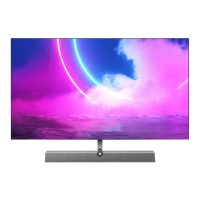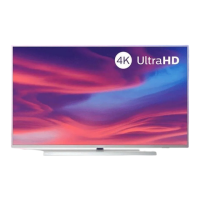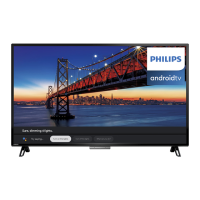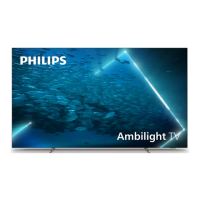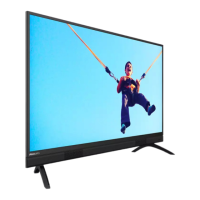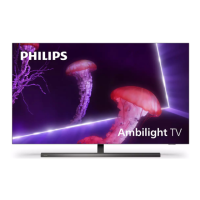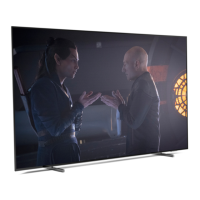
Do you have a question about the Philips 55OLED803 and is the answer not in the manual?
| Screen shape | Flat |
|---|---|
| Response time | - ms |
| Display diagonal | 55 \ |
| Display brightness | - cd/m² |
| Display technology | OLED |
| Native aspect ratio | 16:9 |
| Peak luminance ratio | 65 % |
| Display diagonal (metric) | 139 cm |
| Motion interpolation technology | - |
| RMS rated power | 50 W |
| Number of speakers | 2 |
| PC in (D-Sub) | No |
| HDMI ports quantity | 4 |
| DVI-D ports quantity | 0 |
| USB 2.0 ports quantity | USB 2.0 ports have a data transmission speed of 480 Mbps, and are backwards compatible with USB 1.1 ports. You can connect all kinds of peripheral devices to them. |
| Common interface Plus (CI+) | Yes |
| Component video (YPbPr/YCbCr) in | 1 |
| Audio formats supported | AAC, MP3, WAV, WMA, WMA-PRO |
| Image formats supported | BMP, GIF, JPEG, PNG |
| Video formats supported | AVI, HEVC, MKV, MPEG1, MPEG2, MPEG4, VP9, WMV9 |
| AC input voltage | 220 - 240 V |
| AC input frequency | 50 - 60 Hz |
| Power consumption (standby) | 0.3 W |
| Power consumption (typical) | 144 W |
| Package depth | 160 mm |
| Package width | 1400 mm |
| Package height | 867 mm |
| Package weight | 26200 g |
| Product color | Black |
| Panel mounting interface | 300 x 300 mm |
| Annual energy consumption | 211 kWh |
| Operating temperature (T-T) | 5 - 35 °C |
| Tuner type | Analog & digital |
| Analog signal format system | NTSC, PAL, SECAM |
| Digital signal format system | DVB-C, DVB-S, DVB-S2, DVB-T, DVB-T2, DVB-T2 HD |
| Video apps | Netflix |
| Sports apps | DAZN |
| Operating system version | 7.0 Nougat |
| Operating system installed | Android |
| Stand width | 789 mm |
|---|---|
| Depth (with stand) | 230 mm |
| Height (with stand) | 712.8 mm |
| Weight (with stand) | 21100 g |
| Depth (without stand) | 49.3 mm |
| Width (without stand) | 1227.8 mm |
| Height (without stand) | 705.6 mm |
| Weight (without stand) | 20800 g |
Describes the Home launcher, channels, and system bar features.
Explains how to find and manage apps, including the Philips TV Collection.
Instructs to read safety instructions before using the TV.
Provides instructions for mounting the TV stand and wall mount.
Offers advice on optimal TV placement for viewing and Ambilight.
Details how to connect and handle the power cable.
Explains how to connect the antenna cable for TV signals.
Guides on connecting a satellite dish, with expert help and warnings.
Details the functions of buttons on the top, middle, and bottom of the remote.
Explains the keys of the Easy Remote and pairing instructions.
Describes the IR sensor's function and placement precautions.
Instructions for replacing batteries in the remote control.
Instructions for replacing batteries in the Easy Remote.
Guidance on how to clean the remote control.
Explains how to switch the TV on, off, and to standby mode.
Describes how to operate the TV using its physical buttons.
Guides on installing channels, referencing Help for more details.
Explains channel lists, icons, radio stations, and how to open/search lists.
Details how to sort and filter channels.
Covers tuning, switching channels, locking/unlocking, and parental rating.
How to set preferred and temporary subtitle languages.
How to set preferred and temporary audio languages.
Explains how to create, manage, and use favourite channel lists.
Instructions for using Teletext pages and options.
Explains options for Text/Teletext, language, and Text 2.5.
Covers text language settings and Text 2.5 activation.
Introduces interactive TV (iTV) and HbbTV, covering requirements and usage.
Guides on installing satellites, Unicable, MDU, and settings.
How to adjust satellite installation settings and expert options.
Information on using CAM modules for satellite channels.
Explains satellite channel packages and installation options.
Details Unicable system setup and user band numbers.
Explains how to configure user band frequencies for Unicable.
How to manually update channels.
Steps to add a new satellite to the installation.
Notes on changing installation settings and adding satellites.
Steps to remove satellites and associated channels.
Advanced settings for transponder and LNB.
Guides expert users on manual channel installation.
Troubleshooting common satellite installation issues.
Covers automatic and manual channel updates.
Instructions for reinstalling all channels or the TV.
Details DVB-T/C reception, installation, and channel number conflicts.
Settings for network frequency search.
Manual entry for network frequency.
Methods for scanning channels (Quick vs. Full Scan).
Adjusting step size for channel scanning.
Skipping digital channel search.
Skipping analogue channel search.
Selecting channel types based on subscription.
Checking and improving signal quality.
Purpose of Channel List Copy for dealers and experts.
Requirements for copying channel lists between TVs.
How to check the current channel list version.
How to check the current TV software version.
Steps to copy a channel list to a USB drive.
Checking the current version of the channel list.
Instructions for uploading a channel list to TVs.
General guide on connecting devices with quality cables.
Tips for connecting devices and recognizing their types.
Connecting antenna cables via a set-top box or recorder.
Information on HDMI quality, cables, and HDCP copy protection.
Using HDMI ARC for audio return channel connection.
Connecting mobile devices via MHL for screen sharing and charging.
Operating HDMI CEC compatible devices with the TV remote.
Using CI+ modules for premium HD programs.
Inserting smart cards into CAM modules.
Setting PIN codes for CAM modules.
Connecting Home Theatre Systems via HDMI.
Adjusting audio delay for HTS.
Troubleshooting sound issues with HTS.
Connecting smartphones and tablets wirelessly or wired.
Connecting and operating Blu-ray players.
Connecting and operating DVD players.
Connecting via Component Video.
Pairing and managing Bluetooth devices.
Steps to pair Bluetooth devices with the TV.
How to disconnect or remove Bluetooth devices.
Connecting and adjusting headphone volume.
Connecting game consoles via HDMI or Component Video.
Connecting and formatting USB hard drives for recording.
Steps to format a USB hard drive for TV use.
Connecting and configuring USB keyboards.
Viewing photos, music, and videos from USB flash drives.
Connecting digital cameras to view photos.
Connecting camcorders via HDMI.
Connecting a computer to use the TV as a monitor.
Alternative connection for PC using DVI to HDMI adapter.
Connecting the TV to a network and the internet.
Enjoying TV capabilities via network connection.
Steps for wireless and wired network connections.
Requirements for wireless internet connection.
How to connect to a Wi-Fi network.
Connecting via WPS using a PIN code.
Troubleshooting network and internet connection issues.
Connecting the TV to a network via wired connection.
Viewing network settings and configuring static IP.
Signing in to Google for TV features and app access.
Steps to sign in to Google Account on the TV.
Accessing and configuring Android specific settings.
Navigating the Android TV Home screen and its features.
Managing and using apps on the TV.
Viewing live TV channels.
Tracking and watching content from the Play Next channel.
Renting and watching movies/TV shows via Google Play.
Accessing tutorial videos for TV functions.
Accessing recommended YouTube content.
Adding/removing channels from the Home screen.
Installing and using apps from the Philips TV Collection.
Browsing premium apps in the TV Collection.
Agreeing to terms for Philips TV Collection apps.
Setting privacy preferences for apps.
Overview of apps on the TV and their sources.
Using Google Play for movies, music, and games.
Renting/buying movies and TV shows via Google Play.
Playing music via Google Play Music.
Playing games via Google Play Games.
Downloading and installing apps from the store.
Adding payment methods for Google Play purchases.
Instructions to start and stop apps.
Locking apps based on age rating or creating profiles.
Locking apps rated 18+.
Setting up a restricted profile for app access.
Stopping apps and managing cache/storage.
Checking TV memory usage and free space.
Using USB hard drive for extended storage.
Browsing the internet on the TV.
Using internet browser options like tabs and bookmarks.
Using the TV menu as a Home menu when internet is unavailable.
How to open and navigate the TV Menu.
Switching between connected devices and tuners.
Using remote to play discs via HDMI CEC.
Setting specific options for TV inputs.
Operating connected devices with the TV remote.
Viewing information about connected devices.
Assigning names and types to connected devices.
Changing device names and types.
Rescanning connections to update the Sources menu.
Information on connecting the TV to a network.
Pairing, selecting, and removing Bluetooth devices.
Adjusts picture styles, colour, contrast, sharpness, brightness, and advanced settings.
Selects preset picture styles and customizes them.
Detailed adjustments for key picture parameters.
Advanced options for colour enhancement, contrast, and HDR.
Reduces video noise, MPEG artefacts, and adjusts motion.
Manages residual image, screen saver, and picture display format.
Adjusts sound styles, equalizer, volume, and audio output.
Selects preset sound styles and restores defaults.
Advanced sound adjustments like DTS TruSurround and clear dialogue.
Options like Auto Volume, Night Mode, and Delta Volume.
Configures digital audio output formats and delay.
Setting Ambilight to follow video, colour, flag, or app.
Ambilight styles that react to picture dynamics.
Ambilight styles based on preset colour schemes.
Ambilight styles that follow country flag colours.
Ambilight styles that react to sound dynamics.
Using apps to control Ambilight effects.
Configuring Philips Hue bulbs with Ambilight.
Setting up Hue bulbs to match Ambilight colours.
Turning off Ambilight+hue functionality.
Adjusting how accurately Hue bulbs follow Ambilight.
Using Hue bulbs for lounge light effects.
Adjusting Ambilight brightness and saturation.
Viewing or resetting Ambilight+hue configuration.
Instructions for turning off Ambilight.
More information on Ambilight settings.
Using Ambilight lounge light mode when TV is in standby.
Adjusting energy saving modes.
Turning off the screen to save power.
Using the ambient light sensor for automatic brightness.
Setting timers for automatic TV switch-off.
Selecting TV location (Home/Shop) and adjusting settings.
Adjusting shop mode settings for in-store promotion.
Optimizing picture and audio for shop mode.
Displaying feature logos and banners in shop mode.
Enabling/disabling demo modes.
Adjusting HDMI Ultra HD settings for compatibility.
Changing TV menu and message languages.
Setting preferred audio languages for broadcasts.
Setting preferred subtitle languages.
Setting preferred text languages.
Setting the TV clock and auto mode.
Manually setting the TV clock date and time.
Adjusting time zone and offsets.
Configuring sleep timer for automatic standby.
Viewing installed apps and storage.
Settings for users with hearing or visual impairments.
Enabling adapted audio and subtitles.
Enabling audio description and mixed volume.
Setting codes and locking channels/programmes.
Locking apps based on age rating or profiles.
Setting a PIN for CAM recordings.
Viewing media files from computers or NAS.
Adding and viewing favourite media files.
Accessing popular and last played media files.
Viewing media files from USB flash drives or hard drives.
Playing video files, including options and control bar.
Viewing photo files, including 360 photos and options.
Viewing 360 photos and their playback controls.
Options for browsing and playing photo files.
Options specific to 360 photo files.
Playing music files, including options and controls.
Overview of TV Guide functionality and data sources.
How TV Guide data is received and displayed.
Setting TV Guide to receive data from the internet.
Troubleshooting missing recordings due to TV Guide data changes.
Navigating and using the TV Guide features.
How to open and close the TV Guide.
Switching to a current programme from the TV Guide.
Accessing detailed programme information.
Selecting different days in the TV Guide.
Setting reminders for programmes.
Removing set reminders.
Searching for programmes by genre.
Viewing and managing set reminders.
Scheduling programme recordings.
Cancelling scheduled recordings.
Requirements and process for recording TV programmes.
Essential items for recording (USB drive, channels, clock).
Recording programmes immediately or scheduling them.
Starting an immediate recording.
Scheduling future recordings via TV Guide.
Viewing and managing recorded programmes.
Renaming recordings using a colour key.
Resolving overlapping recording schedules.
Manually adjusting recording times.
Setting automatic time margins for recordings.
Scheduling recordings without a TV programme guide.
Pausing and resuming live TV broadcasts.
Pausing, resuming, and controlling playback.
Replaying current broadcasts.
Using the Philips TV Remote App for phone control.
Casting apps from mobile devices to the TV.
Requirements for Google Cast functionality.
Examples of apps supporting Google Cast.
Steps to cast an app to the TV screen.
Adding AirPlay functionality via Android apps.
Connecting MHL-compliant mobile devices.
Requirements for playing games on TV.
Connecting and using wireless gamepads.
Starting games from consoles or apps.
Setting Ambilight to follow video, colour, flag, or app.
Ambilight styles that react to picture dynamics.
Ambilight styles based on preset colour schemes.
Ambilight styles that follow country flag colours.
Ambilight styles that react to sound dynamics.
Using apps to control Ambilight effects.
Configuring Philips Hue bulbs with Ambilight.
Setting up Hue bulbs to match Ambilight colours.
Turning off Ambilight+hue functionality.
Adjusting how accurately Hue bulbs follow Ambilight.
Using Hue bulbs for lounge light effects.
Adjusting Ambilight brightness and saturation.
Viewing or resetting Ambilight+hue configuration.
Instructions for turning off Ambilight.
More information on Ambilight settings.
Using Ambilight lounge light mode when TV is in standby.
Explains what Top Picks recommends (Now on TV, TV on Demand).
Agreeing to Terms of Use for recommendations.
TV's recommendations for current or upcoming programmes.
Details on how Now on TV provides programme recommendations.
How to open and use the Now on TV feature.
Watching missed or favourite programmes on demand.
Explains the TV on Demand service for watching programmes.
How to open and use the TV on Demand service.
Renting movies from online video stores.
Information on using Netflix with a membership subscription.
Overview of Alexa voice control and its requirements.
Using Alexa Skills to enhance voice control.
Setup process for using Alexa voice control on the TV.
Watching two programmes simultaneously (TV and TV).
Conditions and limitations for using Multi View.
Watching TV in small screen while viewing HDMI device.
Updating TV software via internet or USB.
Steps to update software using an internet connection.
Steps to update software using a USB flash drive.
Searching for Over-the-air Download software updates.
Checking the current TV software version.
Enabling automatic software updates.
Information on open source software used in the TV.
Details on open source licenses.
Receiving announcements on new TV software.
European Energy Label and disposal information.
Explains energy efficiency class and consumption.
Technical specifications for 55" and 65" models.
Guidance on proper disposal of the product and batteries.
Power specifications and saving features.
Details the TV's operating system.
Information on aerial, DVB, and satellite reception.
Screen size and resolution specifications.
Supported computer resolutions via HDMI.
Supported video input resolutions.
Details on TV ports and connections.
List of ports on the side of the TV.
List of ports on the bottom of the TV.
Physical dimensions and weight of the TVs.
Sound output power and technologies.
Supported connections, file systems, and playback formats.
Benefits of registering the TV and website for support.
How to access on-screen help and download manuals.
Solutions for common TV issues like power and remote control.
Troubleshooting power and remote control problems.
Explains normal creaking sounds from the TV chassis.
Steps to check remote control functionality.
Normal behaviour of TV returning to standby.
Troubleshooting missing channels or reception issues.
Instructions for cleaning and protecting the OLED screen.
Explains normal and deep refreshing processes.
Recommendations to prevent image retention on OLED screens.
Troubleshooting picture issues like distortion or no picture.
Troubleshooting sound issues like no sound or poor quality.
Troubleshooting HDMI and USB connection problems.
How to change the TV menu language.
Consulting online support for TV issues.
Contacting consumer care and finding serial numbers.
General safety instructions to prevent hazards.
Precautions against electric shock and fire hazards.
Safety measures for lifting, mounting, and handling the TV.
Precautions to prevent children from toppling the TV.
Warning about small batteries in remote controls.
Ensuring adequate ventilation to prevent overheating.
Safety precautions during lightning storms.
Avoiding hearing damage from headphone use.
Handling the TV in low temperatures.
Precautions regarding humidity and condensation.
Guidelines for cleaning and caring for the TV screen.
Legal terms, warranty information, and pixel characteristics.
Declaration of conformity with EU directives.
TP Vision's commitment to EMF standards.
Accessing terms of use and privacy settings for Smart TV.
Information on terms for Philips TV Collection apps.
Trademark information for MHL.
Trademark information for HDMI.
Trademark information for Dolby Audio.
Trademark information for DTS-HD Premium Sound.
Trademark information for Wi-Fi Alliance.
Trademark information for Kensington security products.
General statement about other trademarks.
Disclaimer for third-party services and software.

